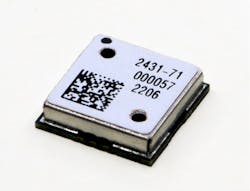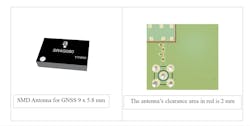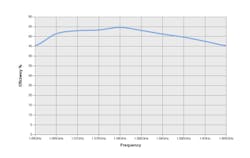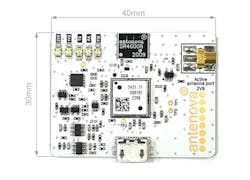GNSS Receivers and Antennas Shrink Size, Power in Positioning Devices
This article is part of the TechXchange: The Internet of Things.
What you’ll learn:
- How the power requirements for GNSS receivers are changing.
- When GNSS receivers consume power.
- How a patch antenna compares with an SMD antenna in a GNSS design.
During 2022, the manufacturers of GNSS receiver modules brought their latest generation of products to market using the latest chipsets, bringing improvements in specifications that can make a real difference in a design. The key criteria for choosing a GNSS module used to be performance, cost-effectiveness, and time-to-first fix (TTFF). The latest GNSS products also offer a smaller footprint, enhanced accuracy, and lower power consumption.
Reducing power consumption is often a game changer. If power consumption is less, a device can run on a smaller battery, so the whole design can shrink down yet have the same battery life.
These changes could trigger something of a revolution in designs for IoT as well as positioning devices and trackers. Foremost, they create interesting opportunities for designers working on smaller designs for battery-powered tracking devices and wearable technology.
Latest GNSS Modules Consume Less Battery Power
For several reasons, GNSS receivers traditionally used a lot of power. First, their power consumption relates to the time spent tracking satellite signals and the number of connections to the satellite. Consequently, devices that track satellites continuously or almost continually consume the greatest amount of power.
Second, multi-band, multi-constellation devices require more power because they’re tracking different constellations that all operate at slightly different frequencies. This means that their antenna must receive all of these, and if an active antenna is added, it will increase the power consumption even further.
Power consumption is critical in tracking devices because they’re mobile and rely on batteries. This means that the life of the battery will limit the time that a tracker can operate before the battery needs to be replaced or recharged.
The latest receivers based on the new AG3335MN chip are significantly reducing power consumption when compared to the previous generation of chips. Mobile devices usually operate with small lithium-ion (Li-ion) batteries, so lower power consumption makes a huge difference in the operational capability of the device. In practice, a vehicle tracker could operate for months more before it requires recharging.
How New GNSS Modules Fix Position More Accurately
TTFF is therefore a key metric in GNSS receivers. Most GNSS modules use the combined data from the GPS, Galileo, GLONASS, and Baidu constellations simultaneously to obtain greater accuracy and more reliable positioning.
Communication to the satellite consumes most of the power; so, if the device can achieve a shorter time to fix, it will use less power. As a result, EASY technology has been implemented in GNSS receivers to accelerate TTFF performance. Around for about a decade, EASY speeds up the TTFF by predicting the ephemeris data for each satellite.
A typical receiver might track three GNSS constellations concurrently and offer configurable low-power modes. All consumer devices support the GPS L1 signal at 1575.45 MHz. Some devices can add data from Galileo, GLONASS, and Baidu to calculate a more accurate position.
For a car tracker, it’s sufficient if the tracker can fix a position to within five meters. Many GNSS receivers offer even greater accuracy and can usually fix a position to within 1.5 m. Some receivers are able to fix a position to within 10 cm or potentially 1 cm. These levels of precision are opening the doors to all kinds of new applications, such as controlling food delivery robots and tracking e-scooters.
Smaller GNSS Modules Can Pair with Smaller Antennas
In the past, the usual choice was to pair a GNSS receiver with a patch antenna. Immediately, the antenna needed more space in the design. A patch antenna is quite large, often as large as 12 or 14 mm square, which is relatively greedy in terms of space on the circuit board of a small device.
However, a patch antenna also needs a bit more space around it. For a patch antenna to work effectively, it requires a ground plane, which is a space on a flat plane around the antenna that allows the signal to radiate when power is turned on. Thus, a patch antenna requires a relatively large amount of space in a device.
There are other differences in the way that patch antennas operate, which might suggest looking for an alternative form of antenna. Patch antennas are narrowband and need to be re-tuned to operate at different frequencies. In other words, they’re effectively custom to the design.
A patch antenna works best when it can be placed in a fixed position, pointing at the sky. This isn’t a serious issue for applications in vehicles or drones, as those can operate well in open space. However, it does mean that the patch antenna is a less-effective choice for small mobile devices, such as wearables and small trackers that will move around and operate in different axes to the signal.
An SMD or chip antenna, or a flexible-printed-circuit (FPC) antenna, often proves to be smaller and neater within a design. Either of these options will use up less volume within a design and if the antenna is chosen with care, it will perform just as well as the more familiar patch antennas.
The ultra-compact modules coming on to the market now are making it possible to redefine the dimensions of your devices. These can be paired with the newer, tiny SMD positioning antennas that also have appeared on the market relatively recently.
GNSS Apps and Capabilities for Positioning Devices
As the specifications improve for GNSS receivers and small positioning antennas, many new areas of applications are opening up thanks to lower power consumption, smaller PCBs, and more accurate positioning.
The greatest opportunities lie in new IoT applications and battery-powered telematics. New designs are being used applications ranging from agriculture, construction, and mining to remote control, robotics, logistics, water utilities, and drones.
New super-accurate positioning technology is making a difference in automated warehouses and robotics, as well as on-board diagnostics (OBDII) in the automotive sector. And in consumer markets, it’s proving useful for wearable devices, fitness trackers, and applications for e-scooters or e-bikes.
A receiver module provides a quick design solution that can be dropped into a design—one just needs to connect the antenna and power. GNSS receivers with integrated antennas enable designers with no special radio-frequency knowledge to achieve a design where the RF is already fully tested and certified, creating a faster route to market.
Design-In Tips for GNSS Receivers and Antennas
Some modules with an integrated antenna must be placed in a position that allows the antenna to radiate and operate correctly. For example, it should be on the edge of the PCB. If the antenna is separate from the GNSS receiver, the manufacturer will specify the optimum position for it. Again, this is usually on the side or a corner of the PCB. A separated antenna will need a matching network to integrate it with the other RF components in the design.
We’re frequently asked how to improve the accuracy of the GNSS and GPS device. We suggest reviewing the antenna’s matching circuit and ensuring that it is tuned correctly. The manufacturer’s datasheets should provide a reference design for this. This will enable the antenna to operate correctly on the optimal frequency bands. If the antenna isn’t properly tuned, it will operate with reduced performance, resulting in a lower signal strength to the receiver.
Read more articles in the TechXchange: The Internet of Things.




